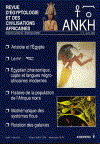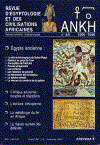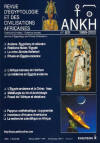|
ANKH n°2,
avril 1993, pp.
164 - 199.

ANKH n°4-5, 1995/1996, pp.
278 - 303.

ANKH n° 8-9, 1999-2000, pp.
144 - 169.

|
Évolution
de la population de l'Afrique noire du néolithique au milieu du 20e siècle.
télécharger/download
Résumé : Berceau de l'humanité,
l'Afrique noire a conservé un potentiel humain relativement important durant toute la
préhistoire. Les conditions naturelles sont comparables à celles de l'Asie méridionale.
Le peuplement s'est accru pendant l'Antiquité, particulièrement dans la région du Nil
Moyen. Du 8e
au 17e siècle, divers témoignages sur le nombre des habitants se recoupent entre
eux et sont progressivement confirmés par l'archéologie.
En partant des résultats du recensement de
1948-1949, on peut estimer à quelque 125/130 millions la population de l'Afrique noire en
1930. Entre 1870 et 1930, l'analyse des faits historiques montre que la population a
diminué de plus du tiers : vers 1850-1870, elle était donc de l'ordre de 200 millions.
Entre 1550 et 1850,
les attaques portugaises et marocaines puis les différentes traites additionnées ont
produit des effets analogues à ceux des guerres de Cent Ans et de Trente Ans en Europe.
En comparant l'habitat du 19e siècle à celui des 15e/16e siècles, on constate que la population du 19e siècle est 3 ou 4 fois moindre.
Il est donc plausible de supposer que l'Afrique noire subsaharienne, vers 1500/1550,
devait probablement compter entre 600 et 800 millions d'habitants, soit 30 à 40 au km2.
Des simulations
numériques effectuées à partir de nombres connus d'esclaves exportés, confirment
l'impossibilité des hypothèses de 4 à 5 habitants/km2 au 16e siècle,
admises jusqu'à présent et corroborent les chiffres ci-dessus indiqués.
Abstract
:
Evolution of the Black Africa population from Neolithic to the middle of the
20th century. —
During the entire period of prehistory, Black Africa, the
cradle of humanity, maintained a relatively large population. The natural conditions are
comparable to those of South Asia. Human inhabitation increased during Antiquity,
especially in the Middle Nile region. From the 8th to the 17th century, various
testimonies related to population density are similar and have been progressively
confirmed as accurate by archaeological findings.
From the results of the 1948-49 census, the
population of Black Africa in 1930 can be put at 125/130 million. An analysis of
historical facts shows that the population had decreased in population by more than one
third of its people between 1870 and 1930. We can thus infer that in 1850-1870, the
population of Sub-Saharan Africa was approximatively 200 million.
Between 1550 and
1850, the Portuguese and Moroccan attacks afterwards the different slave trades added have
produced effects similar to those which the One Hundred Years War and the Thirty Years War
had on Europe. In comparing the settlements of the 19th century to those of the 15th/16th
centuries, it appears that the population in the 19th century is the three or the four
times inferior. It is therefore plausible to assume that Black Africa most likely had a
population of between 600 and 800 million, around 1500/1550, that is to say, 30 to 40
inhabitants per km2.
Numerical
simulations based on known numbers of exported slaves refutes the previously accepted
hypothesis of 4 to 5 inhabitants per km2 during the 16th century, and
confirms the above figures.
La
question de l’Âge du fer en Afrique
télécharger/download
Résumé
: Dès 1952, H. LHOTE avait montré, à l'encontre de
la "théorie carthaginoise" de R. MAUNY, le caractère autochtone de l'industrie noire-africaine du fer,
sans que son argumentation cohérente ait été retenue par les historiens de l'Afrique,
malgré la parution, en 1959, des premières datations de la "civilisation de
Nok" au Nigéria : -3500 BC, -2000 BC, -900 BC, +200 AD (L.M. DIOP, 1968).
Les dates les plus
probantes produites ensuite sont 1°) celles du massif de Termit : en 1972, 10e siècle
BC; en 1988, 14e / 15e siècle BC; en 1992, de 1675 à 2900 BC (cf G. Quéchon); 2°) celles de la région
du lac Victoria-Nyanza : 13e / 15e siècles BC, en 1982 (cf M.C. Van GrunDerbeek, E. ROCHE, H. DOUTRELEPONT).
Les premières dates
de Nok et celle de Ndalane, au Sénégal (environ 2800 BC, cf. C.A. DIOP et
G. DELIBRIAS, 1976) imposent de multiplier les recherches et les
datations dans ces deux régions. Leur corrélation avec les dernières dates se
rapportant au massif de Termit, suggère que la métallurgie du fer est apparue en Afrique
occidentale vers 2800 BC, voire plus tôt.
Le fer trouvé en
Asie et en Nubie est trop tardif pour expliquer la présence en Égypte, de quelques
échantillons de fer de gisement, datant de l'époque des pyramides (27e siècle
BC), alors que l'Égypte est dépourvue de ce minerai. Il n'est pas impossible que le fer
soit venu du Soudan occidental et central par l'Ennedi (cf. remarques de P. HUARD),
dans le cadre d'un réseau d'échanges très étendu, quand le Sahara était moins
désertique.
Abstract :
The Iron Age in Africa.
— H. LHOTE had shown as early as 1952, contrary to R. MAUNY's "Carthaginian
theory" the autochtonous characteristic of Black Africa's iron industry, but his
consistent arguments had not been taken into consideration by historians of Africa, in
spite of the publication in 1959 of the first datations of the Nok civilization in Nigeria
: 3500 BC, 2000 BC, 900 BC, + 200 AD (L. M. DIOP, 1968).
The most convincing
dates produced later are 1°) those of the Termit massif, in 1972, 10th century BC, in
1988, 14th/15th centuries BC, in 1992, from 1675 to 2900 BC (cf. G. QUECHON),
2°) those of lake Victoria-Nyanza region : 13 th/15th centuries BC, in 1982 (cf. M. C.
van GRUNDERBEEK,
E. ROCHE, H. DOUTRELEPONT).
The first dates of
Nok and Ndalane in Senegal (around 2800 BC, cf. C. A. DIOP and G. DELIBRIAS,
1976) impose us to multiply investigations and datings in these two regions. Their
correlation with the last dates concerning the Termit massif, suggest that iron metallurgy
appeared in Western Africa around 2800 BC, if not earlier.
The iron found in
Asia and in Nubia is too late to give an explanation for the presence in Egypt, of a few
samples of an iron deposit dating back to the Pyramid period even though Egypt is lacking
in this ore. It is not impossible that the iron should have come from Eastern and central
Soudan by Ennedi (cf. notes by P. HUARD) in the framework of a very
large spread network of exchanges, when the Sahara was less a desert.
Apport des datations physico-chimiques à la
connaissance du passé de l'Afrique
télécharger/download
Résumé :
Les
grandes étapes de l'évolution de l'homme sur le continent africain ainsi que celles de
ses migrations successives vers les autres continents sont retracées à partir des résultats
des datations physico-chimiques révélant l'âge des vestiges paléo-anthropologiques,
lithiques et archéologiques. Cette synthèse aborde également la période historique qui
débute avec l'apparition de l'écriture vers 3400 avant Jésus-Christ, en Egypte
ancienne. Quoiqu'encore sporadiques, les datations ont permis de restituer l'ancienneté méconnue
et l'avancement des civilisations noires africaines. L'ensemble des différentes datations
corrobore les travaux de Cheikh Anta Diop.
Abstract :
Contribution of the
physico-chemical datings to the knowledge of Africa's past.
—The great stages of the evolution of man on the African continent as well
as those of his migrations towards other continents are related here using the results of
the physico-chemical dating disclosing the age of the paleo-anthropological, lithical and
archaeological remains. This synthesis also tackles the historical period which starts
with the appearance of writing around 3400 B.C., in ancient Egypt. Although still
sporadic, the dating allowed the restitution of the misjudged ancientness and the advanced
state of Black African civilisations. The different datings taken as a whole corroborate
Cheikh Anta Diop's works.
|

